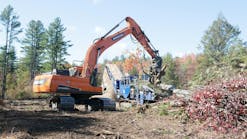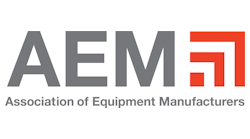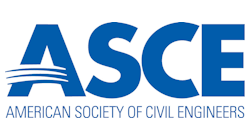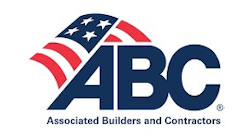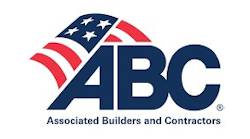Two new game-changing bulldozers are entering the commercial marketplace this year.
In March, John Deere launched sales of the 764 High-Speed Dozer, a machine that Deere says will give operators the ability to do more work in less time. Deere says the 764 HSD allows operators to perform grading and moderate dozing at about double the speed of a similarly sized crawler. Plus, the 764 HSD can travel up to 18 miles per hour across a job site without damaging pavement.
And this fall, Caterpillar plans to start sales of the D7E, the first electric drive track-type tractor using modern technology. Cat says the revolutionary diesel-over-electric drive system developed for track-type tractors gives the D7E an optimum balance of power, fuel efficiency, control, and maneuverability. Cat claims an increase of 25% in fuel efficiency with the D7E, compared to a non-electric dozer of the same size. The D7E ranks in the 60,000-pound weight range and is powered by a Cat C9 engine producing 235 horsepower.
High-Speed Dozing
First let’s take a closer look at John Deere’s 764 High-Speed Dozer. The 764 HSD weighs in at 34,000 pounds and is powered by a 210-horsepower, 6.8-liter John Deere PowerTech Plus engine. The machine features hydrostatic drive. Two hydraulic drive pumps power four hydrostatic motors-one for each of the four track groups.
“This machine has better flotation than a motor grader and better speed than a dozer,” says Dan Drescher, John Deere’s product marketing manager for crawlers. “The reason you have four track groups is so you can articulate the machine, which makes it more maneuverable. Plus you have the flotation of rubber tracks.
“When you turn the machine, the outside track moves faster than the inside track, just like a wheeled vehicle,” says Drescher. He says the high-speed dozer is well suited for site preparation, road-building, and finish grading. The dozer comes equipped with a 3.75-cubic-yard, all-hydraulic six-way blade and a standard Category 4 drawbar, so it can pull implements ranging from scrapers to compactors to discs and box blades.
Speed can be infinitely controlled from 0 to 18 miles per hour, with four ranges available at the touch of a button. Finish grading can be achieved at speeds around twice that of a comparably sized dozer. “The finish grading speed lets operators do precise work faster,” Drescher says. “That means higher production and increased profit.”
The 764 HSD uses a combination of friction and positive drive to propel the machine under load. “Tension drives the track most of the time, but when you hit peak drawbar load, the sprockets pick up cogs on the tracks to provide positive drive,” says Drescher. “The cogs engage when you hit peak drawbar power.”
The 764 HSD is available with Deere’s “plug-and-play” Integrated Grade Control, meaning that the dozer arrives from the factory prewired and ready to receive the operator’s favorite laser/GPS system. In addition, Deere offers the “plug-and-play” Integrated Control option on the full lineup of steel track crawler dozers ranging from the 450J to the 850J.
And in March 2008, John Deere announced the Maximum Life Undercarriage System, which is a balanced life system that includes such larger components as idlers, rollers, and links for a longer wear life, along with improved bushings to link chain seals and match the longevity of the larger components.
On the Deere 650J crawler, for example, the links are 4% taller and 22% wider and heavier. And Deere’s proven SC-2 bushings require one turn in a lifetime. The SC-2 bushings mean slurry coating, which is a coating that is applied to the bushings by the plasma-arc process. “If you get 1,500 hours with regular undercarriage components, with SC-2 you get 3,000 hours before you turn them,” says Drescher.
“Our design goal for the max life undercarriage system is 4,500 hours in abrasive soil conditions,” says Drescher. Undercarriage wear life is dependent on application, soil conditions and maintenance practices.
With the Maximum Life system, customers should experience twice the life of their undercarriage components versus standard undercarriages with sealed and lubed track chain. The Deere Maximum Life Undercarriage System is backed up by the Wear Assurance promise of up to 6,000 hours, depending on the application and soil conditions.
In addition, programmable operator preferences-formerly only offered on the John Deere 750J and 850J-are now standard on the company’s smaller dozers, including the 450J, the 550J, the 650J, and the 700J. That means the operator can program into the machine the: 1) Steering quickness; 2) shift aggressiveness; and 3) the quickness with which the dozer shifts from forward to reverse.
Electric Drive
Next up is Cat’s D7E, which is not a high-drive machine. In the D7E power train, the diesel engine drives a generator to produce electricity that ultimately powers two AC electric drive motors. They are connected to a differential steering system.
A traditional mechanical transmission is not needed, because the variable-speed electric motors serve the function of a continuously variable transmission. The electric drive train has 60% fewer moving parts compared to previous D7 dozers. The electric system also provides power to auxiliary components so that no engine belts are needed.
Cat says the D7E incorporates other design improvements. Most noticeable to the operator is the center-post cab. The cab provides all-around visibility and wider sight lines to the blade for better operator productivity and enhanced job-site safety.
Other D7E features and benefits include the following.
- Electric drive train makes operator training easier, because there are no gears to shift;
- A spacious tilt cab allows ready access for maintenance. The electric air conditioning system is a self-contained module and is located outside the cab. Noise levels in the cab are reduced by 50%.
- A single, larger blade lift cylinder replaces the traditional dual cylinders. The single cylinder provides the power and stability of a dual-cylinder system but with fewer than half the parts. It also aligns with the center post of the cab to enhance visibility.
- The available SystemOne undercarriage reduces undercarriage operating costs by 35% to 70%.
- The optional AccuGrade grade control system can cut job costs significantly. Every D7E will come Grade Control Ready, which allows installation of the AccuGrade Attachment Ready Option at the factory or at the dealer.
Komatsu’s Two Families
Komatsu has two families of dozers. The smaller ones for lighter work and finish grading-the D31, D37, D39 and the 130-hp D51-all now have the cab-forward design that is a recent innovation from Komatsu. All of those machines feature hydrostatic
transmissions.
Les Scott, Komatsu’s product manager, crawler tractors, says the new cab-forward design offers much-improved blade visibility. “It allows the operators to see the ground for a longer period of time as the blade moves into the work; it gives them more time to react,” says Scott. “It allows an inexperienced operator the chance to become a good operator in a shorter period of time.”
The second benefit of the cab-forward design is a better ride. “The old-school operators say it takes about two seconds to adjust to the new seat position,” says Scott. “And they say it makes them a better operator, because of the visibility.”
Komatsu’s larger tractors, the ones designed for heavy-duty dozing and land-clearing operations-from the 168-horsepower D61 up through the mining size dozers like the D375 and D475-have the conventional cab design and a torque converter with a power-shift transmission.
In March 2008, Komatsu made its PLUS undercarriage standard on the D51, D61, and D65 models. P-L-U-S stands for parallel link undercarriage system. The key to the PLUS system is a rotating bushing system, which eliminates bushing wear altogether, Scott says. With conventional bushings, wear occurs when the sprocket grabs the bushing and wears the bushing surface. But with a rotating bushing, the bushing turns around the link assembly. “So there’s no sprocket-to-bushing wear,” says Scott.
In addition, Komatsu made the track links taller and increased the hardness depth. The bottom rollers and top idlers are larger in diameter, and Komatsu increased the hardness depth. “So we have more wear surface on those items,” says Scott. “The link rails, the bottom rollers and the top idlers are all designed to wear out at the same time.”
Scott says the PLUS undercarriages cost about 30% more for the parts-but they double the life of the components. The D51, D61, and D65 dozers now all get PLUS undercarriages. And when Komatsu engineers finish the design work, the D31, D37, and D39 dozers will get PLUS undercarriages as well.
New From Case
At the 2008 World of Concrete Show in Las Vegas, Case Construction Equipment introduced the Case 1650L crawler dozer, the first model in the company’s new L Series dozer line. The 1650L boasts a 144-horsepower Case engine that backs up a variable-displacement dual-path hydrostatic transmission.
“The 1650L is a completely new machine from the ground up,” says Joyce Szulc, Case brand-marketing manager. “In addition to the powerful engine and hydrostatic transmission, it features a new cab design, low-effort electronic blade control and high-performance hydraulics for increased blade speed, superior blade force, and precise control.”
The new machine has a six-cylinder, 6.7-liter turbocharged Case Family IV engine with electronic fuel injection for maximum fuel efficiency. A high-pressure common rail injection system provides excellent combustion, and an air cooler adds to fuel efficiency and reduces emissions.
The hydrostatic drive features electronic straight tracking with counter rotation and selectable settings for shuttle and steering for slow, normal, and fast reaction. There are 10 speed settings with infinitely variable steering for maximum maneuverability with counter rotation.
The new single-lever control on the 1650L provides infinitely adjustable steering for precise and easy operation. By tilting the lever to the left or to the right, the operator can slow the track on that side to turn the machine. When the lever is pushed completely to the side, the machine will counter-rotate in that direction.
“With ergonomic controls and wide-open visibility, the 1650L is as productive as it is easy to operate,” says Szulc. “The advanced hydraulics and steering make for smooth operation, whether you’re doing heavy dozing or finish grading.”
What’s more, Case has announced upgrades to two of its other crawler dozer models. The Case 750L and 850L, each with Tier III engines, replace the 750K and 850K. The new models deliver superior performance and ease of operation with the Case-exclusive PowerStat hydrostatic drive, featuring one-lever control of speed and direction. Case PowerStat components are designed for the high horsepower needed to push the fullest blades, even through curves and turns.
The 750LT has an operating weight of 18,900 pounds, a blade capacity of 2.16 cubic yards and a track-on-ground of 89 inches. The 850 XLT is slightly larger, with an operating weight of 19,600 pounds and the same blade capacity as the 750LT.
If you’re interested in a new dozer, check them out at your local equipment dealers. As always, an informed looker makes a smarter buyer.“These semiconductor advances have been substantial, and they will continue due to the large investments driven by automotive, energy, and other industries,” says Friling. Power semiconductors allow precise and flexible motor control. And when these motors are integrated properly into an overall power train they enable a wide variety of continuously variable transmission designs.
Both pure series electric and parallel drive trains have recently emerged in the construction equipment marketplace. For certain applications of less than 1,000 horsepower, both series and parallel drive trains bring advantages often associated with continuously variable transmissions, such as reduced fuel consumption, increased productivity, and easier-to-operate machines. “The Caterpillar D7E with electric drive is a track-type tractor that highlights these advantages,” says Friling.
Electric technology has the potential to create power trains with fewer moving parts and increased durability. When properly integrated with an overall power train, machine control can be very precise and responsive. Electric drive trains also enable the use of electric accessories that can be controlled to further improve performance and fuel economy. Finally, these drive trains are also inherently ready for application of energy storage to make even further advances in fuel economy.
“As with any new technology there are challenges,” says Friling. “Achieving economies of scale in manufacturing—to drive costs lower—is key for electric drives. As we look to the need to create fuel efficient, environmentally responsible products, electric drive clearly has a place. However, as always, it is about having the right drive train for the right application to meet customer needs.”
